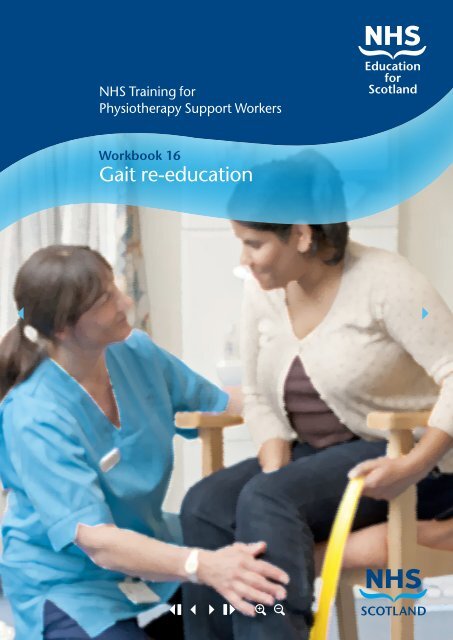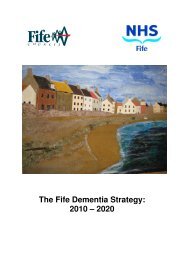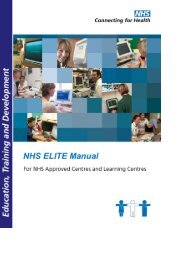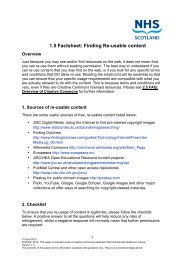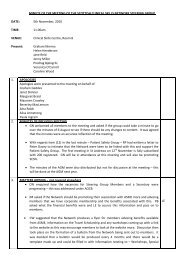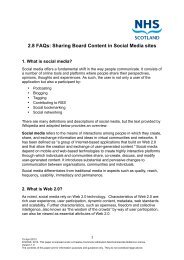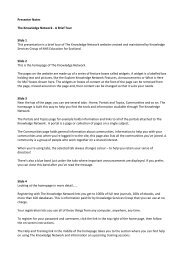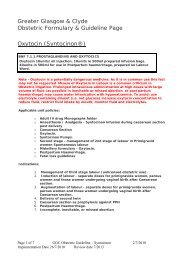Gait re-education
Gait re-education
Gait re-education
You also want an ePaper? Increase the reach of your titles
YUMPU automatically turns print PDFs into web optimized ePapers that Google loves.
NHS Training for<br />
Physiotherapy Support Workers<br />
Workbook 16<br />
<strong>Gait</strong> <strong>re</strong>-<strong>education</strong>
Contents<br />
Workbook 16 <strong>Gait</strong> <strong>re</strong>-<strong>education</strong> 1<br />
16.1 Aim 3<br />
16.2 Learning outcomes 3<br />
16.3 P<strong>re</strong>paration for walking assessment and walking <strong>re</strong>-<strong>education</strong> 4<br />
16.4 <strong>Gait</strong> Patterns 6<br />
16.5 Walking aids and their use 6<br />
16.6 Other walking aids 7<br />
16.7 Measuring the patient for a suitable walking aid 8<br />
16.8 Maintaining the walking aid 9<br />
16.9 Practising walking with patients 10<br />
16.10 Recognising simple gait abnormalities 12<br />
16.11 Identifying when a patient is prog<strong>re</strong>ssing or <strong>re</strong>g<strong>re</strong>ssing 15<br />
16.12 Safety and walking practice 17<br />
16.13 Walking with a patient and two staff 20<br />
16.14 Conducting walking practice with a patient and two staff 22<br />
16.15 Walking <strong>re</strong>-<strong>education</strong> workbook completion 25<br />
16.16 Walking <strong>re</strong>-<strong>education</strong> <strong>re</strong>flection 27<br />
© NHS Education for Scotland 2012. You can copy or <strong>re</strong>produce the information in this<br />
document for use within NHSScotland and for non-commercial <strong>education</strong>al purposes.<br />
Use of this document for commercial purposes is permitted only with the written<br />
permission of NES.
NHS Training for Physiotherapy Support Workers<br />
Workbook 16 | <strong>Gait</strong> <strong>re</strong>-<strong>education</strong><br />
Workbook 16<br />
<strong>Gait</strong> <strong>re</strong>-<strong>education</strong><br />
16.1 Aim<br />
The aim of this training programme is to provide the Healthca<strong>re</strong> Support<br />
Worker (HCSW) with the knowledge, understanding and skills to safely and<br />
effectively <strong>re</strong>-educate gait.<br />
16.2 Learning outcomes<br />
By the end of this workbook you will be able to:<br />
■■<br />
■■<br />
■■<br />
■■<br />
■■<br />
Describe and demonstrate the cor<strong>re</strong>ct patterns of sit to stand and gait<br />
with diffe<strong>re</strong>nt walking aids.<br />
Demonstrate the appropriate p<strong>re</strong>paration of the patient for walking <strong>re</strong>-<strong>education</strong>,<br />
explain the procedu<strong>re</strong> clearly and cor<strong>re</strong>ct performance accordingly.<br />
Identify when it is appropriate to undertake walking practice with two staff<br />
and demonstrate this effectively in a safe co-ordinated manner.<br />
Identify when a patient is prog<strong>re</strong>ssing or <strong>re</strong>g<strong>re</strong>ssing and liaise appropriately<br />
with the therapist.<br />
Identify wear and tear of the walking aid and take appropriate action.<br />
Workbook 16 Page 3
NHS Training for Physiotherapy Support Workers<br />
Workbook 16 | <strong>Gait</strong> <strong>re</strong>-<strong>education</strong><br />
16.3 P<strong>re</strong>paration for walking assessment and walking <strong>re</strong>-<strong>education</strong><br />
As with all other activities with patients you need to conduct a risk assessment prior to<br />
asking the patient to get up to walk. You may be doing this to assist the therapist to assess<br />
the patient, or to practice walking with a patient who has al<strong>re</strong>ady been assessed.<br />
Consider:<br />
■■<br />
■■<br />
■■<br />
■■<br />
■■<br />
■■<br />
■■<br />
■■<br />
■■<br />
Does the patient have the appropriate walking aid?<br />
Is the patient able to participate in the activity?<br />
Does the task <strong>re</strong>qui<strong>re</strong> one or two support workers?<br />
Can the patient follow commands?<br />
A<strong>re</strong> you adequately trained to assist the patient with this particular task?<br />
Whether the patient is wearing appropriate clothing – is the<strong>re</strong> anything that might cause<br />
the patient to stumble or fall?<br />
Does the patient’s footwear fit and is it appropriate for walking in?<br />
A<strong>re</strong> the<strong>re</strong> obstacles in the bed space?<br />
Do you have plenty of time to enable the patient to work at his own pace?<br />
Evidence<br />
Describe a risk assessment and p<strong>re</strong>paration for walking practice that you have conducted<br />
prior to practicing walking with a patient.<br />
What did you find?<br />
Describe actions that you took to ensu<strong>re</strong> safety following risk assessment.<br />
Workbook 16 Page 4
NHS Training for Physiotherapy Support Workers<br />
Workbook 16 | <strong>Gait</strong> <strong>re</strong>-<strong>education</strong><br />
Assisting the patient to stand up<br />
■■<br />
■■<br />
■■<br />
■■<br />
■■<br />
■■<br />
■■<br />
■■<br />
■■<br />
■■<br />
The procedu<strong>re</strong> is explained fully and ag<strong>re</strong>ed with the patient.<br />
Brakes a<strong>re</strong> on when patient is in a mobile chair.<br />
Walking aid is positioned cor<strong>re</strong>ctly.<br />
The patient brings themselves forward to the edge of the chair.<br />
Facilitate normal pattern of sit to stand, to include cor<strong>re</strong>ct positioning of hands and feet,<br />
cor<strong>re</strong>ct sequence of hip and knee movement and trunk extension.<br />
Assess when patient <strong>re</strong>qui<strong>re</strong>s assistance to stand.<br />
Provide appropriate assistance, facilitation or equipment during the assessment.<br />
Provide appropriate feedback to the patient.<br />
Follow therapist guidelines as to the most appropriate aid and assistance for practice of gait.<br />
Remember to provide firm instructions to ensu<strong>re</strong> that the patient turns at the cor<strong>re</strong>ct<br />
time, locates the chair against the back of their legs and uses their arms to control their<br />
<strong>re</strong>turn to the chair.<br />
Evidence<br />
Describe how you assisted one of your patients to stand up and <strong>re</strong>turn to the chair prior<br />
to walking practice.<br />
Describe what you did<br />
What went well?<br />
What could have been better ?<br />
Anything that you would do diffe<strong>re</strong>ntly next time?<br />
Workbook 16 Page 5
NHS Training for Physiotherapy Support Workers<br />
Workbook 16 | <strong>Gait</strong> <strong>re</strong>-<strong>education</strong><br />
16.4 <strong>Gait</strong> Patterns<br />
Normal gait patterns<br />
It is important to understand normal walking patterns befo<strong>re</strong> working with patients<br />
Your supervising therapist will demonstrate the phases of gait.<br />
Swing phase and stance phase of gait<br />
Each leg goes through the same cycle during each step.<br />
Swing phase<br />
The first part is when the toes come off the ground and the leg swings until the heel strikes<br />
the ground. Some patients have difficulty clearing the ground when walking.<br />
Stance phase<br />
This part is whe<strong>re</strong> the heel strikes the ground, the weight is transfer<strong>re</strong>d onto the leg and lasts<br />
until the toes push off the ground. Some patients have problems with this part of the gait<br />
cycle.<br />
16.5 Walking aids and their use<br />
Walking aids a<strong>re</strong> selected according to:<br />
■■<br />
the patient’s balance<br />
■■<br />
the <strong>re</strong>qui<strong>re</strong>d support for weight-bearing<br />
Sticks<br />
Sticks a<strong>re</strong> selected when a patient has good<br />
balance and just a small amount of support<br />
is <strong>re</strong>qui<strong>re</strong>d. The patient would normally be<br />
able to bear most of their weight. Two sticks<br />
a<strong>re</strong> mo<strong>re</strong> stable than one, but the patient<br />
still <strong>re</strong>qui<strong>re</strong>s good balance in order to be<br />
able to use them.<br />
Frames<br />
Frames a<strong>re</strong> selected when the patient<br />
<strong>re</strong>qui<strong>re</strong>s g<strong>re</strong>ater support, since they have<br />
a large base of support to provide stability.<br />
You may notice that a patient is struggling<br />
to walk with sticks and may benefit from a<br />
frame.<br />
The frame may have wheels, or may simply<br />
have four stoppers. The advantage of wheels<br />
is to allow for a mo<strong>re</strong> normal gait pattern.<br />
Workbook 16 Page 6
NHS Training for Physiotherapy Support Workers<br />
Workbook 16 | <strong>Gait</strong> <strong>re</strong>-<strong>education</strong><br />
Furthermo<strong>re</strong>, it <strong>re</strong>qui<strong>re</strong>s less effort to push the frame than it does to lift, thus, it may be<br />
better for frail or b<strong>re</strong>athless patients.<br />
You may <strong>re</strong>cognise that a patient is easily walking with a frame. They may appear not to<br />
<strong>re</strong>qui<strong>re</strong> it to provide weight bearing support, or they may be walking quickly.<br />
They may benefit from prog<strong>re</strong>ssion to two sticks.<br />
If you feel that the patient is <strong>re</strong>ady to prog<strong>re</strong>ss, or <strong>re</strong>qui<strong>re</strong>s mo<strong>re</strong> assistance to walk – contact<br />
the Physiotherapist, who will <strong>re</strong>assess the patient, and p<strong>re</strong>scribe an appropriate walking aid.<br />
16.6 Other walking aids<br />
Auxiliary crutches<br />
These a<strong>re</strong> used when weight must be<br />
<strong>re</strong>lieved from one leg and can be used to<br />
train non-weight bearing.<br />
Elbow crutches<br />
These a<strong>re</strong> sticks of adjustable length with a<br />
horizontal hand grip and a metal fo<strong>re</strong>arm<br />
<strong>re</strong>st. These a<strong>re</strong> not as stable as auxiliary<br />
crutches but with practice a<strong>re</strong> mo<strong>re</strong> flexible<br />
to use. Used for partial or full weightbearing.<br />
Gutter crutches<br />
These provide a gutter splint on top<br />
of adjustable crutch legs and a<strong>re</strong> used<br />
when weight cannot be taken through<br />
the fo<strong>re</strong>arms and hands, for example in<br />
rheumatoid arthritis or wrist fractu<strong>re</strong>.<br />
Workbook 16 Page 7
NHS Training for Physiotherapy Support Workers<br />
Workbook 16 | <strong>Gait</strong> <strong>re</strong>-<strong>education</strong><br />
Activity<br />
Your tutor will demonstrate gait<br />
patterns with:<br />
■■<br />
■■<br />
■■<br />
■■<br />
■■<br />
■■<br />
■■<br />
a walking frame<br />
a mobilator<br />
two sticks<br />
one stick<br />
auxiliary crutches<br />
elbow crutches<br />
gutter crutches<br />
You will also learn about:<br />
■■<br />
■■<br />
■■<br />
■■<br />
■■<br />
■■<br />
■■<br />
full weight-bearing<br />
partial weight-bearing<br />
touch weight-bearing<br />
non-weight bearing<br />
th<strong>re</strong>e point swing-to<br />
th<strong>re</strong>e-point swing-through<br />
four-point gait<br />
16.7 Measuring the patient for a suitable walking aid<br />
It is important that the walking aid is cor<strong>re</strong>ctly measu<strong>re</strong>d to fit the patient.<br />
In the tutorial you will learn about the measu<strong>re</strong>ment of:<br />
■■<br />
■■<br />
■■<br />
■■<br />
■■<br />
■■<br />
■■<br />
a walking frame<br />
a mobilator<br />
two sticks<br />
one stick<br />
auxiliary crutches<br />
elbow crutches<br />
gutter crutches<br />
Measuring the patient<br />
Sticks<br />
With the patient standing as straight as possible, the stick should be adjusted so that it’s<br />
handle is level with the patient’s wrist c<strong>re</strong>ase. When the patient holds the stick, a slight bend<br />
at the elbow should be seen.<br />
Frames<br />
The patient is not normally measu<strong>re</strong>d for use of the frame, but should similarly have enough<br />
elbow flexion to allow the frame to be moved forward comfortably. The patient should not<br />
be stooped, nor should the frame be so high the patient struggles to lift it forward.<br />
Auxiliary crutches<br />
The height should be measu<strong>re</strong>d from the medial malleolus to 5cm below the armpit at the<br />
back.<br />
The hand piece should be adjusted as for sticks, with 15° flexion at the elbow.<br />
Workbook 16 Page 8
NHS Training for Physiotherapy Support Workers<br />
Workbook 16 | <strong>Gait</strong> <strong>re</strong>-<strong>education</strong><br />
Elbow crutches<br />
Measu<strong>re</strong>ment is as for sticks.<br />
Gutter crutches<br />
Measu<strong>re</strong>ment is conducted by measuring the distance between the elbow when it is flexed<br />
to 90°and the floor.<br />
Activity<br />
Practice measuring the cor<strong>re</strong>ct height of each of these walking aids on a model. Was the<strong>re</strong><br />
anything that you found difficult when doing this?<br />
Describe he<strong>re</strong> what happened when you measu<strong>re</strong>d a patient for one of these walking aids.<br />
What went well?<br />
What could have been better?<br />
Anything you would do diffe<strong>re</strong>ntly next time?<br />
16.8 Maintaining the walking aid<br />
■■<br />
■■<br />
■■<br />
■■<br />
You should always check the walking aid for signs of wear and tear<br />
Patients should be instructed to inspect the walking aid for signs of wear and tear<br />
Walking aids should be cleaned <strong>re</strong>gularly and whe<strong>re</strong> possible wheels can be oiled<br />
The ferrules become worn with usage, which may cause the aid to slip on certain surfaces.<br />
If the ferrule shows signs of wear it should be <strong>re</strong>placed<br />
Workbook 16 Page 9
NHS Training for Physiotherapy Support Workers<br />
Workbook 16 | <strong>Gait</strong> <strong>re</strong>-<strong>education</strong><br />
Activity<br />
Describe how you <strong>re</strong>cognised signs of wear and tear on a walking aid and what<br />
action you took.<br />
16.9 Practising walking with patients<br />
Activity<br />
The therapist may ask you to undertake gait practice with patients.<br />
Make a list he<strong>re</strong> of what you should know about the patient befo<strong>re</strong> undertaking<br />
the task.<br />
Workbook 16 Page 10
NHS Training for Physiotherapy Support Workers<br />
Workbook 16 | <strong>Gait</strong> <strong>re</strong>-<strong>education</strong><br />
You might have included information like:<br />
■■<br />
■■<br />
■■<br />
■■<br />
■■<br />
■■<br />
What is the patient t<strong>re</strong>atment plan and what goals is the patient expected to achieve?<br />
What walking aid does the patient <strong>re</strong>qui<strong>re</strong>?<br />
How many people a<strong>re</strong> <strong>re</strong>qui<strong>re</strong>d to assist them walking?<br />
What does the therapist <strong>re</strong>qui<strong>re</strong> me to do?<br />
What should I be helping or encouraging the patient to do when walking?<br />
How often and for how long should the patient be practising with the aid?<br />
Write he<strong>re</strong> whe<strong>re</strong> you would find this information<br />
Evidence<br />
Select a patient with whom you have undertaken a programme of walking practice as<br />
p<strong>re</strong>scribed by the therapist. What walking aid did they use?<br />
Describe what you did?<br />
What went well?<br />
What could have been better?<br />
What would you do diffe<strong>re</strong>ntly next time?<br />
Workbook 16 Page 11
NHS Training for Physiotherapy Support Workers<br />
Workbook 16 | <strong>Gait</strong> <strong>re</strong>-<strong>education</strong><br />
Make su<strong>re</strong> you can:<br />
■■<br />
■■<br />
Safely assist the patient to carry out the gait <strong>re</strong>-<strong>education</strong> plan ag<strong>re</strong>ed with the therapist.<br />
Document the t<strong>re</strong>atment and outcome cor<strong>re</strong>ctly.<br />
For patients using:<br />
a walking frame<br />
a mobilator<br />
two sticks<br />
one stick<br />
auxiliary crutches<br />
elbow crutches<br />
gutter crutches<br />
■■<br />
■■<br />
■■<br />
■■<br />
■■<br />
■■<br />
■■<br />
<br />
16.10 Recognising simple gait abnormalities and cor<strong>re</strong>cting them<br />
appropriately<br />
With injury and illness, a patient’s walking pattern can be very diffe<strong>re</strong>nt from normal.<br />
■■<br />
The patient may dip down at the hip during stance phase.<br />
■■<br />
■■<br />
■■<br />
The patient may find clearing the ground difficult in swing phase. This may lead them to<br />
swing the leg round to swing through.<br />
If they have had a stroke or neurological disorder, they may not be able to support the<br />
weight fully enough to step with the other leg.<br />
Some patients may be unable to pull up their toes enough to place the heel on the<br />
ground.<br />
■■<br />
■■<br />
■■<br />
Patients may lean too far forward on the walking frame.<br />
They may push the frame too far forward.<br />
They may walk with their weight too far back on their heels.<br />
■■<br />
They may walk with one hand on the frame and one on the furnitu<strong>re</strong>!<br />
Workbook 16 Page 12
NHS Training for Physiotherapy Support Workers<br />
Workbook 16 | <strong>Gait</strong> <strong>re</strong>-<strong>education</strong><br />
Activity<br />
With your supervising therapist, look at some of the patients with whom you a<strong>re</strong><br />
practising walking.<br />
Try to decide if they a<strong>re</strong> finding swing or stance phase difficult.<br />
Your supervising therapist will indicate how to assist this patient to walk better.<br />
She may suggest to the patient that they:<br />
■■<br />
■■<br />
Brings their heel down to touch the ground at the end of swing phase.<br />
Bends their knee to clear the ground.<br />
■■<br />
■■<br />
■■<br />
That they straighten their knee and their hip to support their weight better during<br />
stance phase.<br />
That they slightly flex their knee during stance phase to stop the knee from<br />
snapping back.<br />
The instructions that the therapist asks you to use to cor<strong>re</strong>ct the walking pattern of<br />
the patient will depend on the individual and the problems that they have.<br />
Over time you will become familiar with those encounte<strong>re</strong>d on your own unit, |<br />
and be able to provide patients with feedback that enables them to walk better.<br />
Workbook 16 Page 13
NHS Training for Physiotherapy Support Workers<br />
Workbook 16 | <strong>Gait</strong> <strong>re</strong>-<strong>education</strong><br />
Evidence<br />
Describe he<strong>re</strong> the details of a patient whose walking you cor<strong>re</strong>cted under instruction of<br />
the therapist.<br />
Describe how you <strong>re</strong>cognised that the patient was walking abnormally.<br />
What did you do?<br />
What went well and why?<br />
What could have been better?<br />
What would you do diffe<strong>re</strong>ntly next time?<br />
Workbook 16 Page 14
NHS Training for Physiotherapy Support Workers<br />
Workbook 16 | <strong>Gait</strong> <strong>re</strong>-<strong>education</strong><br />
16.11 Identifying when a patient is prog<strong>re</strong>ssing or <strong>re</strong>g<strong>re</strong>ssing and liaising<br />
appropriately with the therapist<br />
Patients change with time and you may notice that a patient is walking better with their<br />
frame, sticks or crutches than p<strong>re</strong>viously.<br />
Evidence<br />
Select a patient that you have been working with who has prog<strong>re</strong>ssed or <strong>re</strong>g<strong>re</strong>ssed in their<br />
use of a walking aid. Discuss with your supervising therapist and the patient which walking<br />
aid would be most suitable.<br />
Describe how you <strong>re</strong>cognised that the patient was <strong>re</strong>ady to prog<strong>re</strong>ss.<br />
What action did you take?<br />
What was the outcome for the patient?<br />
Anything that you might have done diffe<strong>re</strong>ntly?<br />
Workbook 16 Page 15
NHS Training for Physiotherapy Support Workers<br />
Workbook 16 | <strong>Gait</strong> <strong>re</strong>-<strong>education</strong><br />
Evidence<br />
When you have instructed and monito<strong>re</strong>d the patient in the safe use of the new walking aid,<br />
it is important that you allow the patient time to practice with the aid befo<strong>re</strong> <strong>re</strong>viewing their<br />
prog<strong>re</strong>ss.<br />
Indicate how you would <strong>re</strong>view the prog<strong>re</strong>ss of the patient with the aid.<br />
You should <strong>re</strong>view the patient with the aid again, ensuring that they a<strong>re</strong> confident and<br />
comfortable with use of the aid.<br />
If the patient is to keep the aid, ensu<strong>re</strong> that you have completed the appropriate paperwork,<br />
and that you have cor<strong>re</strong>ctly documented in the therapy <strong>re</strong>cords the change in use of the aid.<br />
Your supervising therapist will sign to verify that you can:<br />
■■<br />
■■<br />
■■<br />
■■<br />
■■<br />
contribute to selection of the cor<strong>re</strong>ct walking aid for an individual patient<br />
safely prog<strong>re</strong>ss the patient to a suitable walking aid<br />
ensu<strong>re</strong> that the patient is able to use the walking aid safely and effectively in their<br />
environment<br />
<strong>re</strong>view their prog<strong>re</strong>ss appropriately<br />
complete appropriate documentation<br />
Workbook 16 Page 16
NHS Training for Physiotherapy Support Workers<br />
Workbook 16 | <strong>Gait</strong> <strong>re</strong>-<strong>education</strong><br />
16.12 Safety and walking practice<br />
When assisting patients with mobility or practising gait <strong>re</strong>-<strong>education</strong>, it is most important<br />
that you consider patient safety as a priority.<br />
Case study<br />
Julie is a physio support worker who has been practising walking with Mr Jones in his<br />
home for the past few weeks.<br />
He walks with a stick and has been safe and co-ordinated until now. Julie speaks to his<br />
wife prior to walking Mr Jones. She <strong>re</strong>ports that he is well. When Julie gets him up to<br />
stand, she notices that he is less steady than p<strong>re</strong>viously.<br />
She tries a couple of steps with him, but he becomes mo<strong>re</strong> unsteady and holds onto<br />
her. Julie shouts for his wife to help her sit him down again.<br />
Activity<br />
What should Julie have done? Write your answers he<strong>re</strong>.<br />
Workbook 16 Page 17
NHS Training for Physiotherapy Support Workers<br />
Workbook 16 | <strong>Gait</strong> <strong>re</strong>-<strong>education</strong><br />
■■<br />
Firstly, Julie should have undertaken a risk assessment befo<strong>re</strong> trying to walk with the<br />
patient.<br />
■■<br />
■■<br />
She should have spoken in detail to the patient himself about how he was feeling.<br />
She should have observed that the lack of steadiness was a risk to his safety.<br />
■■<br />
■■<br />
■■<br />
When she <strong>re</strong>alised he was less steady than normal, she should have asked him to sit down<br />
again.<br />
She should have asked him to take a few steps on the spot to assess his balance befo<strong>re</strong><br />
proceeding.<br />
She could have discussed this change in Mr Jones’ ability with him and his wife to<br />
determine whether anything else had changed and for how long he had felt his walking<br />
had been mo<strong>re</strong> unsteady.<br />
■■<br />
She must then <strong>re</strong>port these changes to the physiotherapist when she <strong>re</strong>turns to base.<br />
■■<br />
The therapist would have <strong>re</strong>assessed Mr Jones and decided on what changes to make to<br />
his management.<br />
■■<br />
They could have walked him between two.<br />
■■<br />
Lastly, they may wish to inform the GP of the change in Mr Jones’ condition, since this<br />
may indicate a change in his medical condition.<br />
Workbook 16 Page 18
NHS Training for Physiotherapy Support Workers<br />
Workbook 16 | <strong>Gait</strong> <strong>re</strong>-<strong>education</strong><br />
Evidence<br />
Describe he<strong>re</strong> a case in which you safely carried out the physiotherapist’s<br />
plan for walking practice.<br />
What p<strong>re</strong>cautions did you take?<br />
What instructions did you provide the patient with during practice?<br />
What walking aid did you use and how did you cor<strong>re</strong>ct the patient’s walking pattern?<br />
What instructions did you provide that patient or ca<strong>re</strong>rs with for practice when you a<strong>re</strong><br />
not the<strong>re</strong>?<br />
What did you document and whe<strong>re</strong>?<br />
Anything you would do diffe<strong>re</strong>ntly next time?<br />
Workbook 16 Page 19
NHS Training for Physiotherapy Support Workers<br />
Workbook 16 | <strong>Gait</strong> <strong>re</strong>-<strong>education</strong><br />
16.13 Walking with a patient and two staff<br />
When is it appropriate to undertake walking practice with a patient and two helpers?<br />
The Physiotherapist may decide from her assessment<br />
The physiotherapist will decide following assessment which patients <strong>re</strong>qui<strong>re</strong> the assistance<br />
of two therapists, support workers, or nurses for walking <strong>re</strong>-<strong>education</strong>. They may decide that<br />
the patient can walk only with assistance of two.<br />
When you <strong>re</strong>cognise that the patient is unsafe as a <strong>re</strong>sult of a risk assessment<br />
Although you may know the patient and they may have been assessed by the therapist<br />
al<strong>re</strong>ady, you must be awa<strong>re</strong> that patients change day to day and hour to hour.<br />
It is possible that following a risk assessment, you <strong>re</strong>alise that the<strong>re</strong> has been a deterioration<br />
in what the patient can do and that they a<strong>re</strong> no longer able to practice walking with<br />
one person.<br />
When working with the patient, the<strong>re</strong>fo<strong>re</strong>, you must assess whether:<br />
■■<br />
■■<br />
■■<br />
■■<br />
The patient can move himself out of bed or to stand or mo<strong>re</strong> assistance is <strong>re</strong>qui<strong>re</strong>d.<br />
The patient’s condition has improved or deteriorated.<br />
The patient is confused or can understand what you a<strong>re</strong> asking them to do.<br />
A hoist or sliding system is <strong>re</strong>qui<strong>re</strong>d.<br />
You and your co-worker have the capability to perform the task:<br />
−−<br />
Have you been trained to handle?<br />
−−<br />
A<strong>re</strong> you fit to handle?<br />
−−<br />
A<strong>re</strong> you familiar with the equipment?<br />
−−<br />
A<strong>re</strong> you familiar with the technique?<br />
−−<br />
A<strong>re</strong> you familiar with the patient?<br />
■■<br />
You must also consider the environment<br />
■■<br />
■■<br />
■■<br />
■■<br />
■■<br />
Is the space clear, have hazards been <strong>re</strong>moved?<br />
A<strong>re</strong> the brakes on the bed or chair?<br />
Is the height of the bed adjusted?<br />
Is the cor<strong>re</strong>ct walking aid available?<br />
Is the walking aid in the cor<strong>re</strong>ct position?<br />
It is important that you inform the therapist of any change in condition. She will <strong>re</strong>assess<br />
and may indicate that the patient should practice walking with assistance from two<br />
healthca<strong>re</strong> workers.<br />
Workbook 16 Page 20
NHS Training for Physiotherapy Support Workers<br />
Workbook 16 | <strong>Gait</strong> <strong>re</strong>-<strong>education</strong><br />
Evidence<br />
With your supervising therapist and a patient in your ca<strong>re</strong>, go through the risk assessment<br />
process. Discuss you findings with your supervising therapist.<br />
Describe he<strong>re</strong> a risk assessment that you performed with a patient, that indicated that they<br />
was unable to undertake walking practice with assistance of one person.<br />
What did you do and why?<br />
What went well?<br />
What could have been better?<br />
Would you do anything diffe<strong>re</strong>ntly next time?<br />
What happened as a <strong>re</strong>sult of your risk assessment?<br />
Your supervisor will verify that you can accurately conduct a risk assessment to indicate<br />
when a patient is unsafe or unable to undertake walking practice with only assistance of one.<br />
You must inform the therapist promptly if the<strong>re</strong> is a change in the condition of the patient<br />
that <strong>re</strong>qui<strong>re</strong>s <strong>re</strong>assessment by the therapist.<br />
Workbook 16 Page 21
NHS Training for Physiotherapy Support Workers<br />
Workbook 16 | <strong>Gait</strong> <strong>re</strong>-<strong>education</strong><br />
16.14 Conducting walking practice with a patient and two staff<br />
When co-ordinating a manoeuv<strong>re</strong> such as walking with a patient and two it is very<br />
important that everyone knows what to do and when.<br />
One of you should be the co-ordinator who gives the commands. Decide in advance who<br />
this is to be.<br />
The patient should be very clear about each step of the procedu<strong>re</strong>.<br />
■■<br />
■■<br />
■■<br />
■■<br />
■■<br />
You should explain to the patient exactly what you a<strong>re</strong> going to do and what the patient<br />
should do in each step of the procedu<strong>re</strong>.<br />
If using equipment, you should explain exactly what you a<strong>re</strong> going to use, how it works<br />
and what you expect the patient to do<br />
Of particular importance is clarifying the instruction for standing up and sitting down.<br />
Be su<strong>re</strong> that you, the other therapist and the patient a<strong>re</strong> clear that when you say<br />
‘Ready, steady, stand’, that you all know to stand up on ‘Stand’.<br />
Using this command is clea<strong>re</strong>r than counting 1,2,3, since it is mo<strong>re</strong> obvious when to stand<br />
or sit.<br />
You must ensu<strong>re</strong> that you know whe<strong>re</strong> you a<strong>re</strong> going to walk to and that the distance is<br />
within the capability of the patient.<br />
Once you a<strong>re</strong> certain that the patient is able to weight bear, ensu<strong>re</strong> that the appropriate<br />
walking aid is available and to hand.<br />
Conducting the procedu<strong>re</strong><br />
■■<br />
You should stand on either side of the chair, facing the same di<strong>re</strong>ction as the patient.<br />
■■<br />
■■<br />
You should ensu<strong>re</strong> that the patient moves towards the edge of the chair prior to<br />
attempting the stand.<br />
Your hands should be crossed behind the patient’s back, on the pelvic bone, or on a<br />
handling belt if you a<strong>re</strong> using one. The tallest therapist or nurse should place her arm<br />
across last.<br />
■■<br />
You may use ‘rocking’ to facilitate standing up.<br />
■■<br />
The patients’ hands may be placed flat on the palm of your other hand, so you have a palmto-palm<br />
grip.<br />
■ ■ You must never pull the patient up by dragging under the arms.<br />
■■<br />
■■<br />
You might use a handling belt, or a walking hoist. Your supervising therapist will assist you<br />
to use the appropriate hoist.<br />
You must ensu<strong>re</strong> that one of you leads the manoeuv<strong>re</strong> and explains what you a<strong>re</strong> doing<br />
to the patient. The timing of the move must be co-ordinated and everyone must be clear<br />
about what is happening and when.<br />
Workbook 16 Page 22
NHS Training for Physiotherapy Support Workers<br />
Workbook 16 | <strong>Gait</strong> <strong>re</strong>-<strong>education</strong><br />
It is important to be concerned with the therapy as well as with safe manual handling<br />
techniques.<br />
Remember to cor<strong>re</strong>ct the patient in their walking practice, by providing them with feedback<br />
as they walk.<br />
Evidence<br />
Answer the following questions:<br />
Whe<strong>re</strong> should you stand to assist the patient to stand up with two?<br />
What techniques can you use to assist standing up?<br />
Whe<strong>re</strong> should your hands go to assist the patient to stand up?<br />
What equipment might you use?<br />
What do you think is particularly important to be clear about when walking with the<br />
patient and two therapists?<br />
Workbook 16 Page 23
NHS Training for Physiotherapy Support Workers<br />
Workbook 16 | <strong>Gait</strong> <strong>re</strong>-<strong>education</strong><br />
Returning the patient to the chair<br />
Again the manoeuv<strong>re</strong> needs to be co-ordinated between you. Ensu<strong>re</strong> that as you approach<br />
the chair that the therapists a<strong>re</strong> behind the patient that you assist the patient to step round to<br />
position themselves cor<strong>re</strong>ctly.<br />
The patient should be able to feel the back of the chair with their legs prior to sitting down<br />
and if possible should feel for the chair arms with their hands<br />
Activity<br />
Under supervision with your therapist, go through the steps of<br />
■■<br />
■■<br />
■■<br />
walking with a patient and two support workers<br />
conducting gait cor<strong>re</strong>ction<br />
<strong>re</strong>turning the patient to the chair<br />
Acknowledgements<br />
NHS Tayside<br />
Workbook 16 Page 24
NHS Training for Physiotherapy Support Workers<br />
Workbook 16 | <strong>Gait</strong> <strong>re</strong>-<strong>education</strong><br />
16.15 Walking <strong>re</strong>-<strong>education</strong> workbook completion<br />
Your supervising physiotherapist will sign your portfolio to indicate that you have<br />
completed this workbook successfully.<br />
Objective Physiotherapist’s signatu<strong>re</strong> Date<br />
Demonstrate the cor<strong>re</strong>ct pattern<br />
of sit to stand<br />
Describe and demonstrate various<br />
gait patterns with diffe<strong>re</strong>nt walking<br />
aids<br />
Safely assist a patient to carry out<br />
the gait <strong>re</strong>-<strong>education</strong> plan ag<strong>re</strong>ed<br />
with the therapist<br />
Document the t<strong>re</strong>atment and<br />
outcome of your t<strong>re</strong>atment cor<strong>re</strong>ctly<br />
Provide a patient with simple<br />
instructions to cor<strong>re</strong>ct his walking<br />
pattern according to the plan<br />
determined by the physiotherapist<br />
Identify when a patient is<br />
prog<strong>re</strong>ssing or <strong>re</strong>g<strong>re</strong>ssing and take<br />
appropriate action<br />
Contribute to selection of the<br />
cor<strong>re</strong>ct walking aid for an individual<br />
patient<br />
Workbook 16 Page 25
NHS Training for Physiotherapy Support Workers<br />
Workbook 16 | <strong>Gait</strong> <strong>re</strong>-<strong>education</strong><br />
Objective Physiotherapist’s signatu<strong>re</strong> Date<br />
Demonstrate the cor<strong>re</strong>ct pattern<br />
of sit to stand<br />
Safely prog<strong>re</strong>ss the patient to a<br />
suitable walking aid<br />
Ensu<strong>re</strong> that the patient is able to use<br />
the walking aid safely and effectively<br />
in their environment<br />
Accurately and safely measu<strong>re</strong><br />
appropriate patients for walking aids<br />
Recognise signs of wear and tear on<br />
the walking aid and take appropriate<br />
action when <strong>re</strong>qui<strong>re</strong>d<br />
Accurately conduct a risk assessment<br />
to indicate when a patient is unsafe<br />
or unable to undertake walking<br />
practice with only assistance of one<br />
Support worker (name)<br />
Support worker’s signatu<strong>re</strong><br />
Physiotherapist (name)<br />
Physiotherapist’s signatu<strong>re</strong><br />
Date<br />
Workbook 16 Page 26
NHS Training for Physiotherapy Support Workers<br />
Workbook 16 | <strong>Gait</strong> <strong>re</strong>-<strong>education</strong><br />
16.16 Walking <strong>re</strong>-<strong>education</strong> <strong>re</strong>flection<br />
Suggested KSF Dimensions: C2, HWB2, HBW7<br />
This form should be placed in the appropriate section of your portfolio.<br />
What did you learn from this module?<br />
How has this influenced your work?<br />
Date module completed<br />
Date module completed<br />
Workbook 16 Page 27
G<strong>re</strong>ater Glasgow<br />
and Clyde<br />
Tayside


